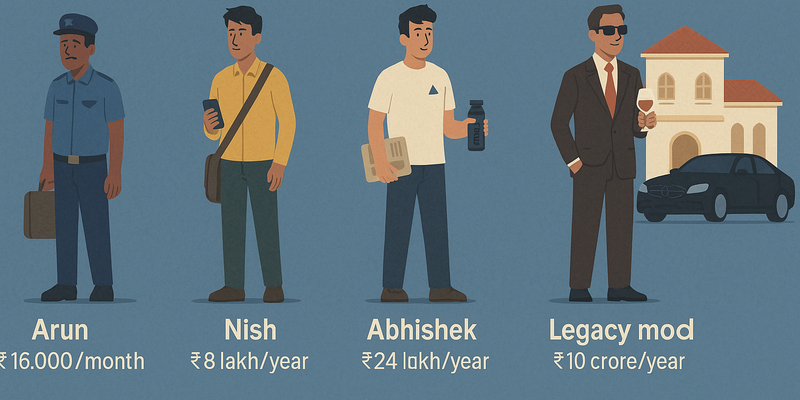
In video games, you start with basic resources, level up, gain powers, and eventually unlock “god mode.” In real life, especially in India, the game of wealth works similarly — but not everyone starts on the same map.
India’s income inequality isn’t just economic; it’s emotional, physical, and psychological. As of 2024, the top 10% of Indians control over 80% of the nation’s wealth. The bottom 50%? They share just 3%. So what does life look like at each stage of this economic pyramid? Let’s meet four “players,” each on a different level of India’s wealth game — from daily-wage earners to ultra-high-net-worth elites.
Level 1: ₹16,000/month — Surviving, not living
Arun earns ₹16,000 a month as a security guard in Bangalore. He’s part of the 90% of Indians who earn under ₹25,000/month. After sending ₹9,000 home to support his wife and children, he’s left with ₹1,500 for himself. Rent, basic meals, and the occasional ₹10 samosa drain what little remains.
This isn’t a budgeting problem — it’s a bandwidth crisis. His 12 to 24-hour shifts leave him too exhausted to upskill or job-hunt. With no insurance, one illness could destroy everything. The idea of financial planning doesn’t even exist at this level. It’s pure survival mode.
He represents the working poor: 41 crore informal sector workers whose labour sustains India’s economy but who remain excluded from its upward mobility.
Level 2: ₹8 lakh/year — The middle-class illusion
Nish earns ₹66,000 a month working in a fintech startup. He can afford a shared flat, 10-minute grocery apps, skincare routines, and even the occasional Uber Eats order. He sends ₹20,000 home to his retired parents and saves via SIPs.
He’s technically in India’s top 10% — but still feels poor. The pressure to “do better” is constant. From EMIs to marriage to home loans, his life is a tightrope walk between aspiration and anxiety.
This is the Indian middle class — literate, tech-enabled, and financially aware, but perpetually stretched. They are the country’s engine of consumption and dreams, yet rarely feel in control.
Level 3: ₹24 lakh/year — Financial freedom with a caveat
Abhishek, an AI engineer, earns ₹2 lakh/month. He lives in a premium apartment, invests ₹30,000 monthly, buys protein bars, travels quarterly, and still manages to save tens of thousands every month.
He’s not worried about monthly survival — he’s optimising taxes and reading finance blogs. He has insurance, emergency funds, and future planning tools. Most importantly, he can afford therapy — a privilege only 7% of Indians can claim.
At this level, wealth is not just about money. It’s about time, health, and mental space. But it’s still precarious: a layoff or crash could destabilize everything.
Level 4: ₹10 crore/year — Legacy mode, system-shaping wealth
Suraj, a real estate mogul, earns over ₹10 crore annually. He owns a ₹27 crore villa, three luxury cars, a fleet of advisors, and spends ₹8 lakh/month dining at India’s finest places. His net worth is measured not in salary, but in assets — land, companies, trusts, and equity.
His money doesn’t just buy things. It buys influence. He lobbies for policies, sits on industry boards, and shapes markets. While Arun wonders about rent, Suraj decides whether to build a mall or a Michelin-starred restaurant.
At this level, money protects itself. Through tax optimisation, offshore holdings, and philanthropy, the ultra-rich grow richer — even during recessions. India currently has over 1,000 ultra-high-net-worth individuals (UHNWI), a number growing rapidly.
The myth of the “fair game”
This isn’t just a tale of personal finance — it’s a lesson in structural privilege. The “wealth game” isn’t fair. Most people don’t get to roll the dice, let alone dream of winning.
We’re told to save, invest, and work hard — but upward mobility is far more dependent on starting position than skill. The Just World Fallacy, the belief that people get what they deserve — is comforting, but inaccurate. As economist Thomas Piketty notes, without redistribution, capitalism tends toward extreme inequality.
So, what’s the takeaway?
Wealth isn’t just a number — it’s access to healthcare, stability, rest, and even hope. ₹16,000 and ₹10 crore aren’t just different incomes; they represent different Indians, each with its own rules and realities.
And while we may all be playing the same game on paper — in practice, some are running marathons while others spawn with jetpacks.
Edited by Rahul Bansal

